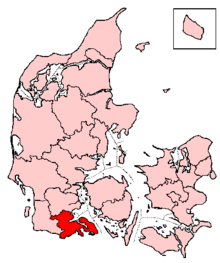Åbenrå-Sønderborg Office
Aabenraa-Sønderborg Amt was an administrative district in Denmark from 1932 to 1970 .
It was formed in 1932 from the relatively small offices Aabenraa Amt and Sønderborg Amt . The old administrative districts retained their own assembly of representatives ( amtsråd ), but were administratively grouped under a common head of office. Because of this hybrid position , the plural term Aabenraa-Sønderborg amter was also used in Denmark . The first head of office was Kresten Refslund Thomsen , who remained in office until 1954. Before that, he had been head of office in Aabenraa from 1920 to 1932.
Brundlund Castle , which was already used by the Aabenraa Office, remained the official seat .
With the municipal reform in 1970 , Aabenraa-Sønderborg Amt was merged into the new Sønderjyllands Amt .
geography
Aabenraa-Sønderborg Amt comprised the south-eastern part of North Schleswig with the island of Alsen and the Sundewitt peninsula . The western part consists of flat, mostly sandy heather areas with meadows and moors, the eastern part, bordering the Baltic Sea, has fertile clay soils and mixed beech forests. In the south the Flensburg Fjord forms a natural border, on the northern official border the Knivsberg reaches a height of 97 m.
history
The referendum in Schleswig in 1920 created national minorities on both sides of the border. Aabenraa-Sønderborg was the scene of the initially tense relationship between the two ethnic groups. Until it was blown up in August 1945, a Bismarck tower rose on the Knivsberg as a gathering point for the German-speaking minority . The Düppeler Mühle , a Danish national symbol , is also located in the official area.
The head of the office, Kresten Refslund Thomsen, tried to find a balancing policy so as not to encourage demands for a new border revision. During the German occupation he followed the cooperative line of the Danish government , both because of his self-image as a loyal civil servant and out of inner conviction. For this he received clear criticism from resistance circles. Refslund Thomsen was also temporarily arrested on May 26, 1944 during a wave of arrests against Danish police officers, officers and civil servants in the districts of northern Schleswig . Nevertheless, after the end of the war he was attacked hard because of alleged collaboration . However, he remained in office and continued to try to reconcile the national differences. a. by promoting a school policy free of repression towards the German minority as a member of the school commission.
The DNSAP , the Danish counterpart to the NSDAP , had its stronghold in Aabenraa-Sønderborg Amt and especially in the parish of Varnæs . This was probably because the party leader Frits Clausen came from Aabenraa and lived in Bovrup. However, the party achieved only modest success across the country, even during the German occupation of Denmark .
From 1944, the Frøslev internment camp for Danish prisoners from the Gestapo and SS was located in the south of the office . The return transports of Scandinavian concentration camp prisoners as part of the rescue operation of the White Buses made a stop here in the spring of 1945. From Schloss Brundlund, Count Folke Bernadotte conducted negotiations with representatives of the Nazi regime . Immediately after the end of the war, Frøslev was taken over by the Danish resistance movement and used until 1949 under the name Faarhus camp to intern members of the German minority and Danish collaborators.
Individual evidence
- ^ Gerret Liebing Schlaber: Hertugdømmet Slesvigs forvaltning. Administrative structures og retspleje mellem Ejderen og Kongeåen approx. 1460-1864 , Flensburg 2007, p. 411
- ↑ JP Trap: Danmark . Vol. 10, Part. 3, p. 801
- ↑ JP Trap: Danmark . Vol. 10, Part. 3, p. 814
- ↑ Nicolai Jonge: Danmarksbeskrivelse, 1777 (Danish; PDF; 26 kB)
- ↑ René Rasmussen, Mindretallene nord and syd for grænsen 1920-1945. Online article at grænseforeningen.dk
- ↑ Entry "Thomsen, Kresten Refslund" on grænseforeningen.dk
- ↑ Ingeborg Refslund Thomsen: Hjemme i Nordslesvig . Gyldendal, Copenhagen 1961, pp. 128-138
literature
- Gerret Liebing Schlaber: Hertugdømmet Slesvigs forvaltning. Administrative structures and retspleje mellem Ejderen and Kongeåen approx. 1460-1864 , ed. from the study department of the Danish Central Library for South Schleswig, Flensburg 2007. ISBN 978-87-89178-65-3
- Ingeborg Refslund Thomsen: Hjemme i Nordslesvig . Gyldendal, Copenhagen 1961
- JP Trap: Danmark . Edited by Niels Nielsen, Peter Skautrup and Therkel Mathiassen, vol. 10, vol. 3. Gads Forlag, Copenhagen 1967.
